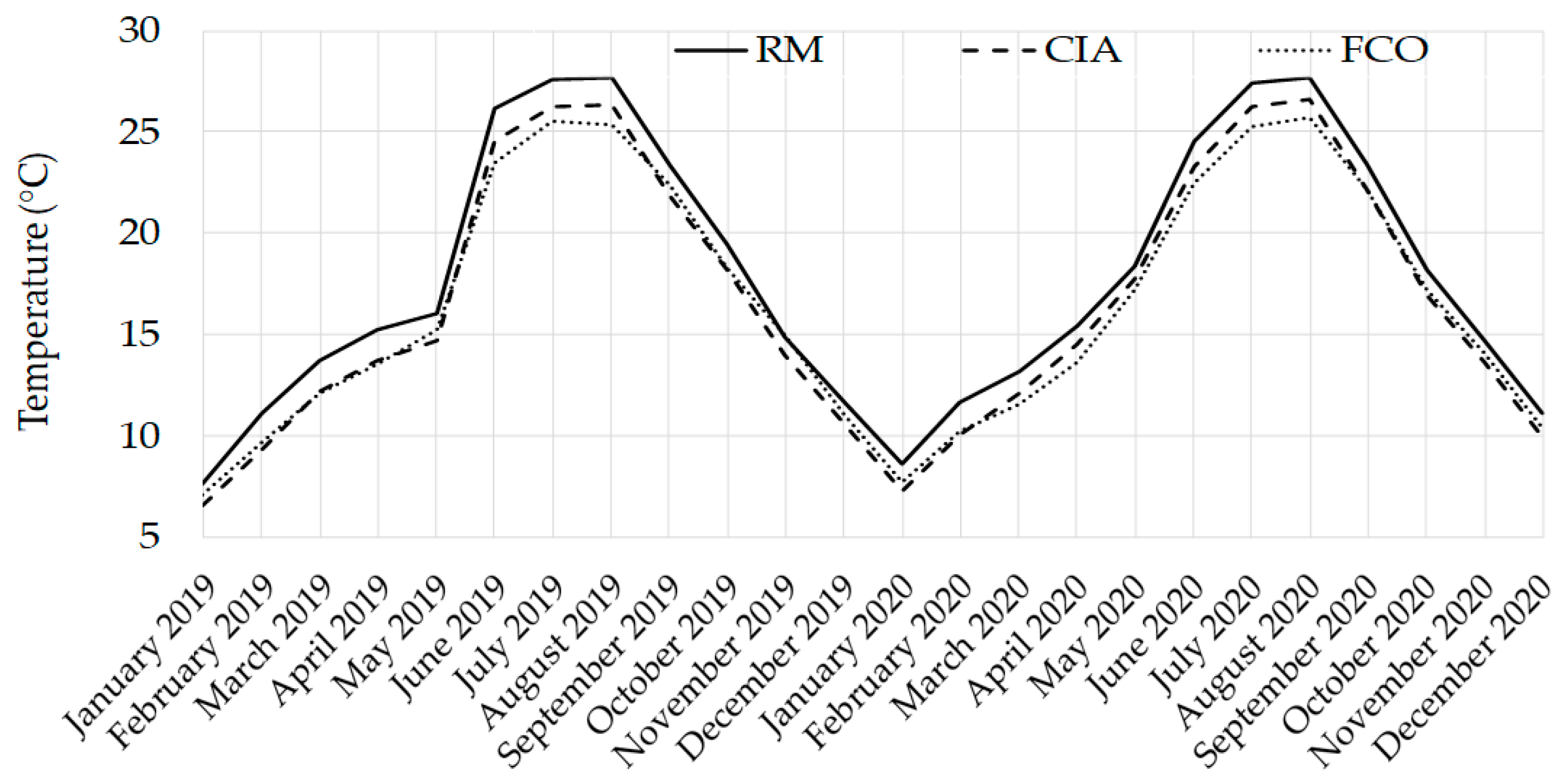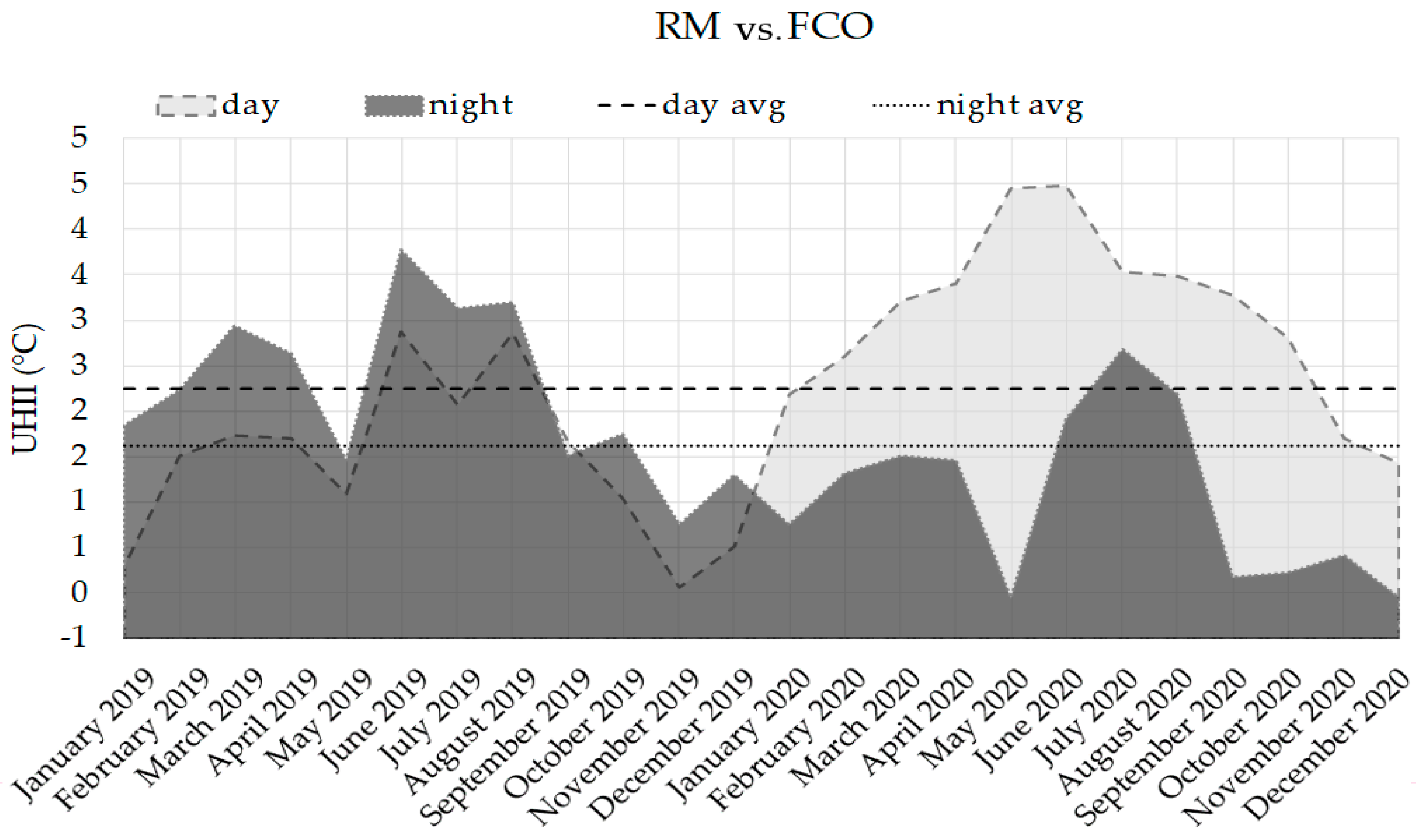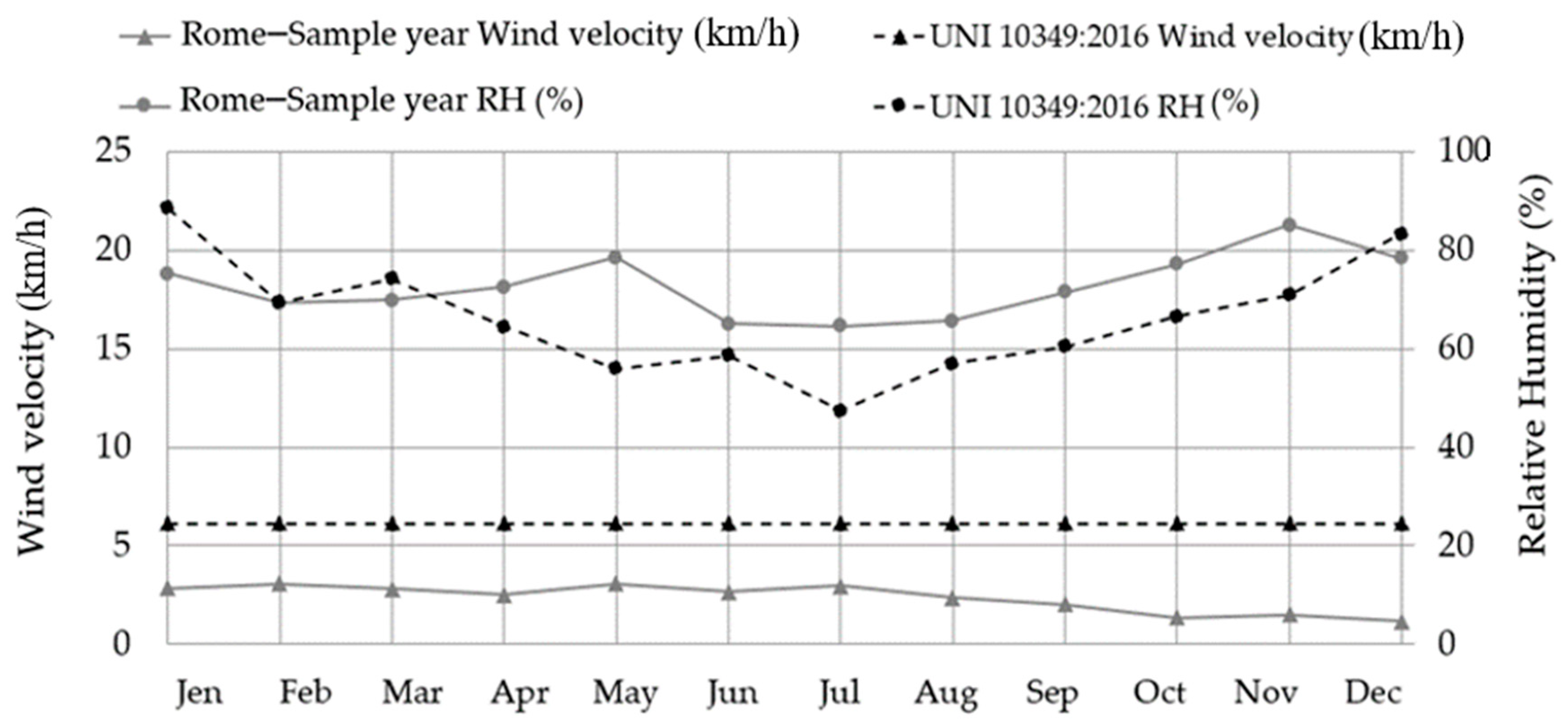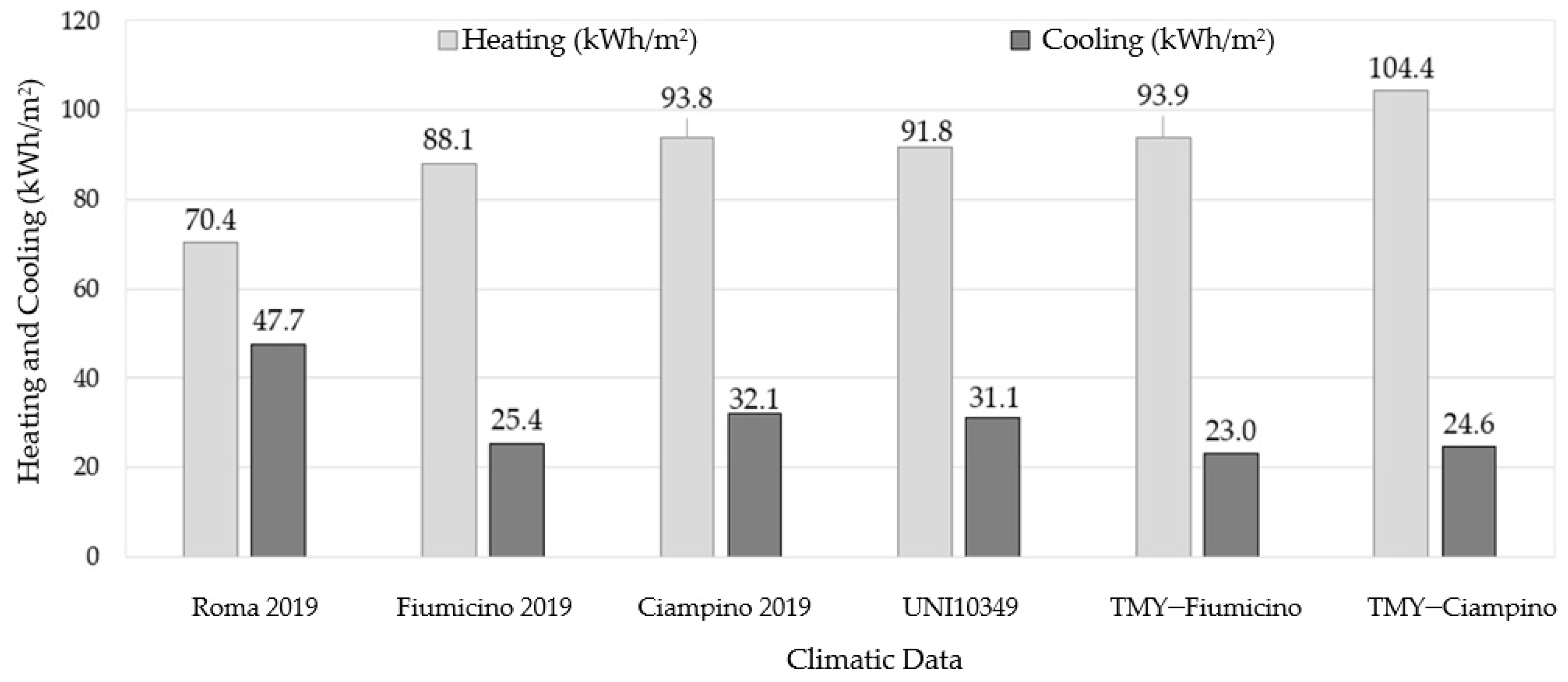Urban Overheating Impact: A Case Study on Building Energy Performance
Abstract
:1. Introduction
2. Materials and Methods
- The biennial meteorological data obtained from two airports near the city (Fiumicino and Ciampino airports) and in a densely built Rome neighborhood were examined and compared considering the same time interval (from January 2019 to December 2020), evaluating the differences in terms of temperature, wind velocity and relative humidity of the three different areas;
- Monthly average maximum and minimum temperatures were processed and used for evaluating the Urban Heat Island Intensity (UHII) in Rome. In order to quantify the UHI phenomenon, the day and night UHI intensity was used, calculated according to the following expressions:
- Analysis of the influence of the different actual weather data recorded in 2019 by the selected stations of Rome, Fiumicino and Ciampino on the annual heating and cooling energy needs of a detached building, through the dynamic software TRNSYS;
- Comparison between the annual heating and cooling energy needs obtained using the TMY available for building energy simulations in Rome, UNI 10349:2016 and actual climatic data in 2019 in order to quantify the differences due to the use of unrealistic climate files.
3. Results and Discussion
3.1. UHI in Rome: Climatic Data Comparison
3.2. Effects of Different Climatic Scenarios on BES
4. Conclusions
Author Contributions
Funding
Institutional Review Board Statement
Informed Consent Statement
Data Availability Statement
Acknowledgments
Conflicts of Interest
References
- International Energy Agency, I. Global Status Report for Buildings and Construction 2019. Available online: https://www.iea.org/reports/global-status-report-for-buildings-and-construction-2019%09 (accessed on 3 May 2021).
- Ignatius, M.; Wong, N.H.; Jusuf, S.K. The significance of using local predicted temperature for cooling load simulation in the tropics. Energy Build. 2016, 118, 57–69. [Google Scholar] [CrossRef]
- Ente Italiano di Normazione (UNI). UNI 10349-1: 2016.. Riscaldamento e Raffrescamento Degli Edifici-Dati Climatici—Parte 1. Available online: http://store.uni.com/catalogo/uni-10349-1-2016?josso_back_to=http://store.uni.com/josso-security-check.php&josso_cmd=login_optional&josso_partnerapp_host=store.uni.com (accessed on 3 May 2021).
- Comitato Temotecnico Italiano. Available online: https://www.cti2000.it/index.php?controller=news&action=show&newsid=34848 (accessed on 5 March 2021).
- Battista, G.; Evangelisti, L.; Guattari, C.; De Lieto Vollaro, E.; De Lieto Vollaro, R.; Asdrubali, F. Urban heat Island mitigation strategies: Experimental and numerical analysis of a university campus in Rome (Italy). Sustainability 2020, 12, 7971. [Google Scholar] [CrossRef]
- Kim, S.W.; Brown, R.D. Urban heat island (UHI) variations within a city boundary: A systematic literature review. Renew. Sustain. Energy Rev. 2021, 148, 111256. [Google Scholar] [CrossRef]
- Mauri, L.; Battista, G.; de Lieto Vollaro, E.; de Lieto Vollaro, R. Retroreflective materials for building’s façades: Experimental characterization and numerical simulations. Sol. Energy 2018, 171, 150–156. [Google Scholar] [CrossRef]
- Yuan, J.; Farnham, C.; Emura, K. Performance of Retro-Reflective Building Envelope Materials with Fixed Glass Beads. Appl. Sci. 2019, 9, 1714. [Google Scholar] [CrossRef] [Green Version]
- Li, X.; Zhou, Y.; Yu, S.; Jia, G.; Li, H.; Li, W. Urban heat island impacts on building energy consumption: A review of approaches and findings. Energy 2019, 174, 407–419. [Google Scholar] [CrossRef]
- Yang, X.; Peng, L.L.H.; Jiang, Z.; Chen, Y.; Yao, L.; He, Y.; Xu, T. Impact of urban heat island on energy demand in buildings: Local climate zones in Nanjing. Appl. Energy 2020, 260, 114279. [Google Scholar] [CrossRef]
- Abbassi, Y.; Ahmadikia, H.; Baniasadi, E. Prediction of pollution dispersion under urban heat island circulation for different atmospheric stratification. Build. Environ. 2020, 168, 106374. [Google Scholar] [CrossRef]
- Battista, G. Analysis of the Air Pollution Sources in the city of Rome (Italy). Energy Procedia 2017, 126, 392–397. [Google Scholar] [CrossRef]
- Xie, Q.; Sun, Q.; Ouyang, Z. Monitoring Spatiotemporal Evolution of Urban Heat Island Effect and Its Dynamic Response to Land Use/Land Cover Transition in 1987–2016 in Wuhan, China. Appl. Sci. 2020, 10, 9020. [Google Scholar] [CrossRef]
- Alexandri, E.; Jones, P. Temperature decreases in an urban canyon due to green walls and green roofs in diverse climates. Build. Environ. 2008, 43, 480–493. [Google Scholar] [CrossRef]
- Battista, G.; Vollaro, E.D.L.; Vollaro, R.D.L. How Cool Pavements and Green Roof Affect Building Energy Performances. Heat Transf. Eng. 2021, 1–15. [Google Scholar] [CrossRef]
- Tostado-Véliz, M.; Icaza-Alvarez, D.; Jurado, F. A novel methodology for optimal sizing photovoltaic-battery systems in smart homes considering grid outages and demand response. Renew. Energy 2021, 170, 884–896. [Google Scholar] [CrossRef]
- Tostado-Véliz, M.; Mouassa, S.; Jurado, F. A MILP framework for electricity tariff-choosing decision process in smart homes considering ‘Happy Hours’ tariffs. Int. J. Electr. Power Energy Syst. 2021, 131, 107139. [Google Scholar] [CrossRef]
- Marrone, P.; Gori, P.; Asdrubali, F.; Evangelisti, L.; Calcagnini, L.; Grazieschi, G. Energy Benchmarking in Educational Buildings through Cluster Analysis of Energy Retrofitting. Energies 2018, 11, 649. [Google Scholar] [CrossRef] [Green Version]
- Tostado-Véliz, M.; Bayat, M.; Ghadimi, A.A.; Jurado, F. Home energy management in off-grid dwellings: Exploiting flexibility of thermostatically controlled appliances. J. Clean. Prod. 2021, 310, 127507. [Google Scholar] [CrossRef]
- Parizotto, S.; Lamberts, R. Investigation of green roof thermal performance in temperate climate: A case study of an experimental building in Florianópolis city, Southern Brazil. Energy Build. 2011, 43, 1712–1722. [Google Scholar] [CrossRef]
- Bollman, M.A.; DeSantis, G.E.; Waschmann, R.S.; Mayer, P.M. Effects of shading and composition on green roof media temperature and moisture. J. Environ. Manag. 2021, 281, 111882. [Google Scholar] [CrossRef]
- Battista, G.; Vollaro, R.D.L.; Zinzi, M. Assessment of urban overheating mitigation strategies in a square in Rome, Italy. Sol. Energy 2019, 180, 608–621. [Google Scholar] [CrossRef]
- Roman, K.K.; O’Brien, T.; Alvey, J.; Woo, O. Simulating the effects of cool roof and PCM (phase change materials) based roof to mitigate UHI (urban heat island) in prominent US cities. Energy 2016, 96, 103–117. [Google Scholar] [CrossRef]
- Diz-Mellado, E.; López-Cabeza, V.; Rivera-Gómez, C.; Roa-Fernández, J.; Galán-Marín, C. Improving School Transition Spaces Microclimate to Make Them Liveable in Warm Climates. Appl. Sci. 2020, 10, 7648. [Google Scholar] [CrossRef]
- Aboelata, A. Vegetation in different street orientations of aspect ratio (H/W 1:1) to mitigate UHI and reduce buildings’ energy in arid climate. Build. Environ. 2020, 172, 106712. [Google Scholar] [CrossRef]
- Theeuwes, N.E.; Solcerová, A.; Steeneveld, G.-J. Modeling the influence of open water surfaces on the summertime temperature and thermal comfort in the city. J. Geophys. Res. Atmos. 2013, 118, 8881–8896. [Google Scholar] [CrossRef] [Green Version]
- Fahed, J.; Kinab, E.; Ginestet, S.; Adolphe, L. Impact of urban heat island mitigation measures on microclimate and pedestrian comfort in a dense urban district of Lebanon. Sustain. Cities Soc. 2020, 61, 102375. [Google Scholar] [CrossRef]
- Battista, G.; Vollaro, E.D.L.; Grignaffini, S.; Ocłoń, P.; Vallati, A. Experimental investigation about the adoption of high reflectance materials on the envelope cladding on a scaled street canyon. Energy 2021, 230, 120801. [Google Scholar] [CrossRef]
- Matias, M.; Lopes, A. Surface Radiation Balance of Urban Materials and Their Impact on Air Temperature of an Urban Canyon in Lisbon, Portugal. Appl. Sci. 2020, 10, 2193. [Google Scholar] [CrossRef] [Green Version]
- Evangelisti, L.; Guattari, C.; Asdrubali, F. On the sky temperature models and their influence on buildings energy performance: A critical review. Energy Build. 2019, 183, 607–625. [Google Scholar] [CrossRef]
- TRNSYS. Transient System Simulation Tool. Available online: http://www.trnsys.com (accessed on 1 May 2021).
- El Bat, A.M.; Romani, Z.; Bozonnet, E.; Draoui, A. Thermal impact of street canyon microclimate on building energy needs using TRNSYS: A case study of the city of Tangier in Morocco. Case Stud. Therm. Eng. 2021, 24, 100834. [Google Scholar] [CrossRef]
- World Meteorological Organization. World Meteorological Organization–Weather–Climate–Water. Available online: https://public.wmo.int/en (accessed on 3 March 2021).
- Qiu, G.Y.; LI, H.Y.; Zhang, Q.T.; Chen, W.; Liang, X.J.; Li, X.Z. Effects of Evapotranspiration on Mitigation of Urban Temperature by Vegetation and Urban Agriculture. J. Integr. Agric. 2013, 12, 1307–1315. [Google Scholar] [CrossRef]
- Lazaridis, M. Environmental Pollution. In First Principles of Meteorology and Air Pollution; Springer: Dordrecht, The Netherlands, 2011; Volume 19, ISBN 978-94-007-0161-8. [Google Scholar]
- Mayer, H. Air pollution in cities. Atmos. Environ. 1999, 33, 4029–4037. [Google Scholar] [CrossRef]
- Evangelisti, L.; Guattari, C.; Gori, P.; Bianchi, F. Heat transfer study of external convective and radiative coefficients for building applications. Energy Build. 2017, 151, 429–438. [Google Scholar] [CrossRef]
- Costanzo, V.; Evola, G.; Marletta, L.; Gagliano, A. Proper evaluation of the external convective heat transfer for the thermal analysis of cool roofs. Energy Build. 2014, 77, 467–477. [Google Scholar] [CrossRef]
- Asdrubali, F.; Venanzi, D.; Evangelisti, L.; Guattari, C.; Grazieschi, G.; Matteucci, P.; Roncone, M. An Evaluation of the Environmental Payback Times and Economic Convenience in an Energy Requalification of a School. Buildings 2020, 11, 12. [Google Scholar] [CrossRef]
- Orsini, F.; Marrone, P.; Asdrubali, F.; Roncone, M.; Grazieschi, G. Aerogel insulation in building energy retrofit. Performance testing and cost analysis on a case study in Rome. Energy Rep. 2020, 6, 56–61. [Google Scholar] [CrossRef]
- Marrone, P.; Asdrubali, F.; Venanzi, D.; Orsini, F.; Evangelisti, L.; Guattari, C.; Vollaro, R.D.L.; Fontana, L.; Grazieschi, G.; Matteucci, P.; et al. On the Retrofit of Existing Buildings with Aerogel Panels: Energy, Environmental and Economic Issues. Energies 2021, 14, 1276. [Google Scholar] [CrossRef]
- Nardi, I.; de Rubeis, T.; Taddei, M.; Ambrosini, D.; Sfarra, S. The energy efficiency challenge for a historical building undergone to seismic and energy refurbishment. Energy Procedia 2017, 133, 231–242. [Google Scholar] [CrossRef]
- Evangelisti, L.; Guattari, C.; Grazieschi, G.; Roncone, M.; Asdrubali, F. On the Energy Performance of an Innovative Green Roof in the Mediterranean Climate. Energies 2020, 13, 5163. [Google Scholar] [CrossRef]










| Stations | Acronym | m.a.s.l. | Coordinates |
|---|---|---|---|
| Fiumicino | FCO | 3 m | 41°47′53.66″ N, 12°14′22.36″ E |
| Ciampino | CIA | 129 m | 41°48′29.49″ N, 12°35′5.82″ E |
| Rome | RM | 51 m | 42°20′22.402″ N, 12°24′35.438″ E |
| Layer | Thickness (m) | Thermal Conductivity (W/mK) | Specific Heat Capacity (J/kgK) | Mass Density (kg/m3) |
|---|---|---|---|---|
| Plaster | 0.02 | 0.700 | 1000 | 1400 |
| Solid bricks | 0.58 | 0.770 | 840 | 1600 |
| Plaster | 0.02 | 0.700 | 1000 | 1400 |
| Climatic Data | Heating (kWh/m2) | Cooling (kWh/m2) |
|---|---|---|
| Rome 2019 | 70.4 | 47.7 |
| Fiumicino 2019 | 88.1 | 25.4 |
| Ciampino 2019 | 93.8 | 32.1 |
| UNI 10349 | 91.8 | 31.1 |
| TMY Fiumicino | 93.9 | 23.0 |
| TMY Ciampino | 104.4 | 24.6 |
| Climatic Data | Percentage Difference (%) | |
|---|---|---|
| Heating | Cooling | |
| Rome 2019 vs. Fiumicino 2019 | −20.1 | +87.5 |
| Rome 2019 vs. Ciampino 2019 | −24.9 | +48.7 |
| Rome 2019 vs. UNI 10349 | −23.3 | +53.3 |
| Rome 2019 vs. TMY Fiumicino | −25.0 | +107.0 |
| Rome 2019 vs. TMY Ciampino | −32.5 | +94.0 |
Publisher’s Note: MDPI stays neutral with regard to jurisdictional claims in published maps and institutional affiliations. |
© 2021 by the authors. Licensee MDPI, Basel, Switzerland. This article is an open access article distributed under the terms and conditions of the Creative Commons Attribution (CC BY) license (https://creativecommons.org/licenses/by/4.0/).
Share and Cite
Battista, G.; Roncone, M.; de Lieto Vollaro, E. Urban Overheating Impact: A Case Study on Building Energy Performance. Appl. Sci. 2021, 11, 8327. https://doi.org/10.3390/app11188327
Battista G, Roncone M, de Lieto Vollaro E. Urban Overheating Impact: A Case Study on Building Energy Performance. Applied Sciences. 2021; 11(18):8327. https://doi.org/10.3390/app11188327
Chicago/Turabian StyleBattista, Gabriele, Marta Roncone, and Emanuele de Lieto Vollaro. 2021. "Urban Overheating Impact: A Case Study on Building Energy Performance" Applied Sciences 11, no. 18: 8327. https://doi.org/10.3390/app11188327
APA StyleBattista, G., Roncone, M., & de Lieto Vollaro, E. (2021). Urban Overheating Impact: A Case Study on Building Energy Performance. Applied Sciences, 11(18), 8327. https://doi.org/10.3390/app11188327








